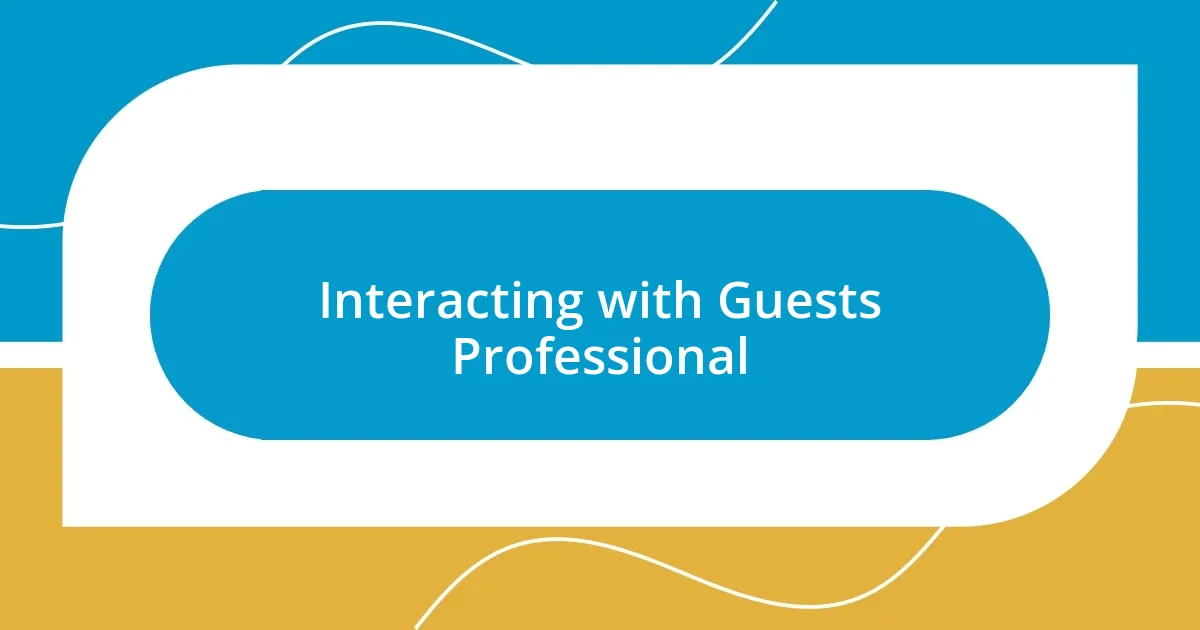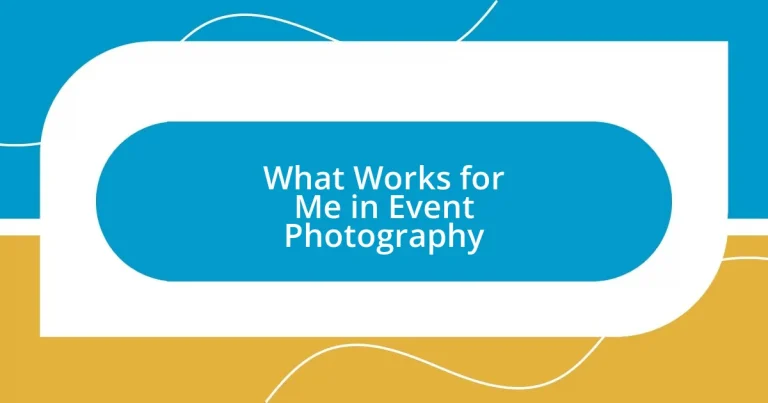Key takeaways:
- Understanding event nuances, lighting, and composition enhances the emotional impact of photographs.
- Selecting appropriate equipment and mastering lighting techniques are crucial for capturing high-quality images at events.
- Building rapport with guests leads to authentic moments, enriching the overall photography experience.
- Effective communication and setting clear expectations with clients result in higher satisfaction and trust in your work.

Understanding Event Photography Basics
When I first started in event photography, I realized that understanding the event itself is crucial. Each event has its own energy and vibe, whether it’s a wedding, corporate gathering, or a birthday party. Have you ever noticed how different the atmosphere feels at a formal gala compared to a casual outdoor picnic? Tuning into these nuances shapes how I capture the moments that matter.
Lighting is another fundamental aspect that I’ve learned through trial and error. I remember vividly shooting a friend’s wedding in a dimly lit venue, struggling to get clear shots. It taught me to adapt my settings quickly and understand how natural light, or the lack of it, impacts my photography. By being aware of lighting conditions, I can create more compelling images that truly reflect the mood of the occasion.
Composition plays a vital role as well. I often find myself framing shots in my mind even before I raise the camera. For instance, at a recent event, I spotted an emotional moment between the bride and her father during the father-daughter dance. By positioning myself strategically, I captured a frame filled with raw emotion that not only told a story but also evoked feelings for anyone looking at the photo. Isn’t that what we all want to achieve with our photography?

Choosing the Right Equipment
Choosing the right equipment for event photography can significantly impact the quality of your images. I remember when I first ventured into a large conference; I brought my trusty DSLR, but I quickly realized that carrying multiple lenses and a flash was essential. The versatility allowed me to adapt to various moments, whether it was capturing a speaker on stage or a candid interaction between guests.
Having the right gear isn’t just about the camera body; it’s also about the accessories. Choosing a reliable tripod and a good camera bag is critical. I once had a mishap where my bag ripped mid-event, and a lens fell out. Fortunately, it was fine, but my heart raced! That experience taught me to invest in sturdy equipment that can withstand the hectic pace of a live event.
Here’s a quick comparison table of essential equipment options:
| Equipment Type | Recommended Options |
|---|---|
| Camera Body | DSLR vs. Mirrorless |
| Lenses | 50mm vs. 24-70mm |
| Flash | External vs. On-camera |
| Tripod | Lightweight vs. Heavy-duty |
| Camera Bag | Backpack vs. Shoulder bag |

Mastering Lighting Techniques
Lighting can make or break your event photos, and I’ve certainly learned this the hard way. I recall a particular outdoor wedding where the sun was setting behind the couple, casting long shadows. Instead of panicking, I embraced the moment and used the golden light to create an ethereal backdrop, turning what could have been a challenge into a breathtaking opportunity. This experience taught me to respect and work with natural light; it often reveals the most stunning moments in unexpected ways.
Here are some lighting techniques I’ve found invaluable:
- Golden Hour Magic: Schedule shots during the first hour after sunrise or the last hour before sunset for softer, warmer lighting.
- Use Reflectors: Keep a small reflector handy; it can bounce light back onto your subjects and fill in shadows beautifully.
- Adjust Your ISO: In low-light situations, raising your ISO can help capture sharper images without using a flash.
- Manual Settings Mastery: Learning to shoot in manual mode allows me to adjust for changing light conditions on the fly.
- Embrace Shadows: Don’t shy away from shadows; they can add depth and dimension to your photos when used intentionally.
Each event offers unique lighting challenges, and finding solutions on the spot becomes part of the artistry. During a recent gala, I was captivated by a spontaneous dance-off on the dance floor. The dim lights and vibrant colors provided a beautiful backdrop. I adjusted my settings quickly, capturing the exhilarating energy of the moment. That’s the beauty of mastering lighting—it empowers you to capture life’s vivid stories in their best light.

Composing Engaging Shots
Composing an engaging shot is about telling a story in a single frame. I vividly remember a bustling festival where I zeroed in on a group of children laughing as they chased bubbles. The way they interacted with the transient bubbles created a moment that spoke volumes. By focusing on their expressions and cutting out distracting backgrounds, I was able to encapsulate pure joy in that click.
I often think about the Rule of Thirds when I compose my shots. By aligning subjects along imaginary lines that split the image into thirds, I naturally create a more balanced and interesting photograph. I recall photographing a corporate event where I framed the keynote speaker off-center, allowing the audience’s reactions to fill the remaining space. This not only highlighted the speaker but also captured the atmosphere of engagement, inviting viewers to feel part of the experience.
Sometimes, framing isn’t just about what’s within the shot; it’s also about what you leave out. At a recent art exhibit, I found a chance to photograph a stunning sculpture set against a blank wall. I chose to include more negative space around it, enhancing its elegance and drawing the viewer’s eye directly to the art. Isn’t it fascinating how subtraction can amplify significance? By intentionally composing my shots this way, I’ve learned that less can truly be more.

Interacting with Guests Professional
Interacting with guests at events is essential for capturing authentic moments. I remember a lively birthday party where I took the time to engage with the guests, asking them about their favorite memories of the celebrant. Through these conversations, I discovered unique interactions and candid reactions that I might have missed had I stayed behind the lens. It really hit me that building rapport sparks genuine smiles and laughter that translate beautifully into photos.
I’ve found that being approachable is key. At a recent corporate event, I made an effort to introduce myself to attendees and share a bit about what I do. This small gesture not only made them feel more comfortable around me, but it also opened up opportunities for interactive shots. Have you ever noticed how people light up when they realize they’re part of something special? That connection often translates into delightful, unguarded moments that can elevate my portfolio.
I aim to be a familiar face rather than just a photographer. At a wedding, I offered to take a few group shots for families, and their gratitude was palpable. They relaxed as I guided them through poses, making the session feel more like fun than work. In those moments, it became clear that interacting genuinely with guests not only enriched my photographs but also left them with positive memories of the experience. Don’t you agree that a little kindness can go a long way?

Post Processing for Better Results
After the excitement of the event, post-processing becomes my secret weapon for transforming good shots into great ones. I remember a wedding where the lighting was tricky—some photos had uneven exposure. By carefully adjusting brightness and contrast during editing, I was able to bring out the joyous expressions of the couple without losing the mood of the moment. Isn’t it incredible how a little tweaking can drastically enhance the emotional impact of an image?
I often incorporate color correction in my workflow to make sure the photos reflect the true essence of the event. At a recent gala, the vibrant decor was overshadowed by muted colors in my raw images. By boosting saturation and adjusting the hues, I was able to revive the ambiance and showcase the lively atmosphere, making the photos pop with energy. Have you ever noticed how colors can evoke feelings? It’s such a powerful tool in our editing arsenal.
Lastly, I touch up details to keep the focus on my subjects. A few months back, I captured candid moments at a charity run, but some images had distracting elements that took away from the main action. I learned to use cropping effectively to eliminate these distractions, honing in on smiles, exhaustion, and triumph in a single frame. It’s astonishing how much clarity can be achieved through mindful post-processing, isn’t it? Every little detail matters in telling the story of an event.

Tips for Client Satisfaction
When it comes to client satisfaction, communication is everything. I recall a time when a couple hired me for their engagement shoot. They were apprehensive about being in front of the camera, so I took the time to sit down with them before the session and discussed their vision. By understanding their expectations, I was able to tailor the experience to their needs; their relief during our shoot was palpable, and those authentic moments we captured reflected their personalities perfectly. Isn’t it amazing how a little conversation can make such a difference?
Setting clear expectations is also crucial. During my early days in event photography, I once promised a quick turnaround on editing, only to find myself overwhelmed after the event. The worried messages from my clients taught me the importance of being realistic about delivery timelines. Now, I always inform clients about my editing process and the timeframe involved, ensuring they feel informed and valued. Have you ever received a gift that took longer than expected? That anticipation can be bittersweet, can’t it?
Finally, I strive to seek feedback actively. At a recent anniversary celebration, I reached out to the couple after delivering their photos. Their suggestions for future projects not only helped me grow but also reinforced their trust in my work. Listening to clients creates a partnership, making them feel invested in the process. Don’t you think that fostering an open dialogue elevates the experience for everyone involved?














